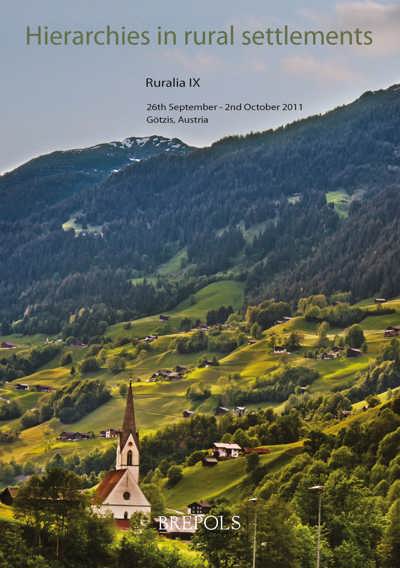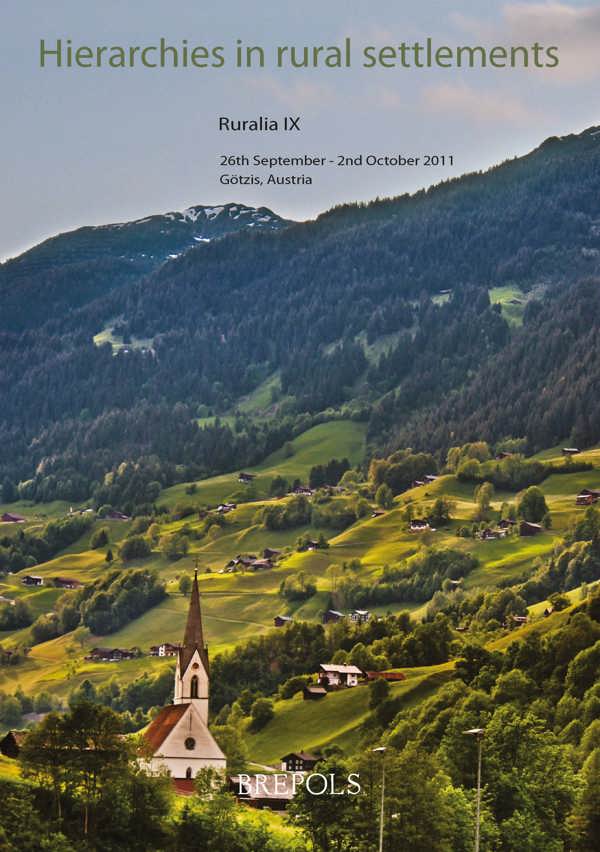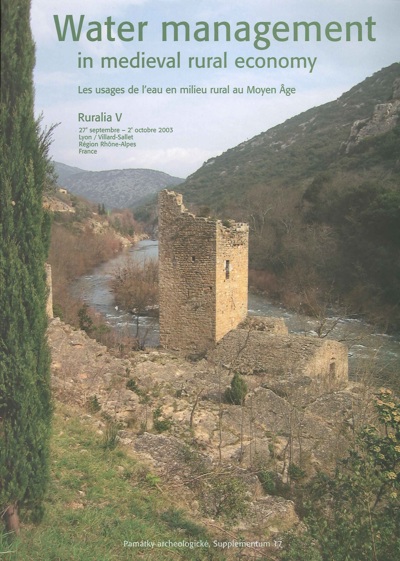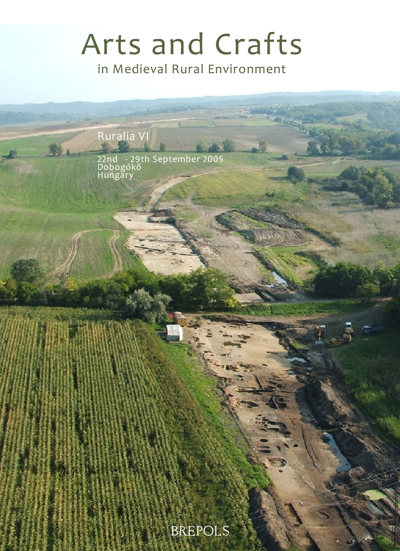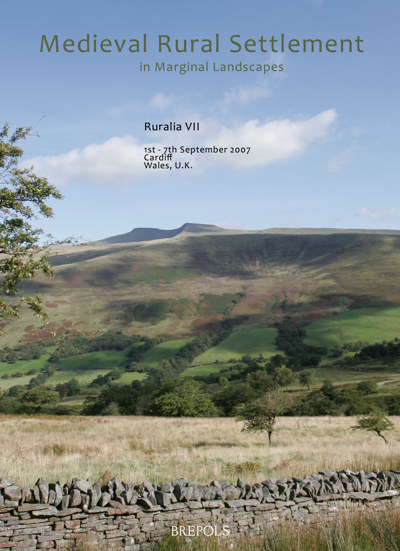
Hierarchies in rural settlements
Hierarchien in ländlichen Siedlungen. Des hiérarchies dans l’habitat rural
Jan Klapste (ed)
- Pages: 462 p.
- Size:210 x 297 mm
- Illustrations:22 col.
- Language(s):English, French, German
- Publication Year:2013
- € 110,00 EXCL. VAT RETAIL PRICE
- ISBN: 978-2-503-54517-2
- Paperback
- Available
- € 110,00 EXCL. VAT RETAIL PRICE
- ISBN: 978-2-503-54518-9
- E-book
- Available
"With 30 papers (22 in English), 462 pages and an A4 format (perfect for the numerous illustrations), this is certainly a substantial collection of essays, but is it successful as a themed research volume? The answer is yes. (...) These are just a handful of the papers that this reader found particularly interesting, and there are too many excellent contributions to mention them all individually." (Stephen Rippon, in: Medieval Archaeology, Vol. 58, 2014, p. 410)
"In summary, Ruralia IX: Hierarchies in Rural Settlement" lives up to the expectations created by the preceding eight volumes. Although a greater sense of coherence and scholarly direction could have been created by a different editorial approach, especially in the ordering of the contributions, many points of contact, both in approaches and interpretations, can be detected between the individual chapters, bearing witness to the success of these conferences - 20 years after their inception - in developing archaeologically comparative dialogues across Europe." (Letty Ten Harkel, in: The Journal of the Medieval Settlement Research Group 30, 2015, p. 68-69)
«Bien documenté (bibliographie, cartes et plans, relevés de fouilles), l’ouvrage auquel ils ont contribué constitue à la fois un état des lieux et une base solide pour de nouvelles avancées.» (Willy Steurs, dans le Moyen Age, 3-4, 2015, p. 877)
The Ruralia, Volume 9, includes thirty papers dealing with the various aspects of social and economic hierarchy in the rural settlement in medieval Europe mainly from archaeological point of view. The authors from 15 countries provide a broad overview of the current issues, complemented for the most part by extensive bibliographies. Very important are also the high quality figures.
The main topics include the differentiation of rural social and economic structure, reflected, for example, in the building culture and various aspects of everyday life. The topic of discussion is the hierarchy of power and the many ways it is presented in archaeology. The focus is on the manor houses and manorial farms, as well as the grain mills in rural areas and the impact of mining activity.
The Ruralia, Volume 9, represents one of the current fields of European archaeological research and offers a solid foundation for further comparative studies.
Sabine Felgenhauer-Schmiedt, Zur Präsenz von Herrschaft im Dorf des Mittelalters in Ostösterreich – iu.
Herbert Knittler, Molendinum & villa. Überlegungen zu Mühlenstandorten im nördlichen Niederösterreich 13. bis 17. Jahrhundert.
Benno Furrer, Hierarchies in villages in the Swiss Alps. Even in the cradle of democracy not all men are equal.
Paolo de Vingo, The hierarchy of power in early medieval villages in central Southern Piedmont.
Claus Kropp - Thomas Meier, Ein historisches Modell in archäologischer Perspektive: „Grundherrschaft" im älteren Mittelalter.
Stefan Krabath - Sonja König, Herrschaft im ländlichen Raum Mitteldeutschlands. Mittelalterliche Siedlungen geprägt durch Repräsentation, Fortifikation oder wirtschaftliche Aspekte.
Rainer Schreg, Commons, cooperatives and village communes – geographical and archaeological perspectives on the role of rural lower classes in settlement restructuring on the Swabian Alb plateau.
Heiko Steuer, Settlements in the southern Black Forest: Castles and mining (dominance through commerce).
Heinrich Stiewe, Niederdeutsche Hallenhäuser als Herrenhäuser Beispiele des 16. bis 18. Jahrhunderts aus Nordwestdeutschland.
W. Haio Zimmermann, Depictions of upper-class farmhouses in the Flemish and Dutch 15th- to early 17th-century art. Farms with towers and/or stone houses as representations of farms with a higher hierarchical status.
Édith Peytremann, Identifier les résidences des élites au sein des habitats ruraux du VIe au XIe siècle dans la moitié nord de la France.
Juan Antonio Quirós Castillo, Archaeology of power and hierarchies in early medieval villages in North of Spain.
Jan van Doesburg, Manors (curtes): new archaeological evidence from the Netherlands.
Michel Lascaris, Gräben als strukturierende Elemente innerhalb hochmittelalterlicher Dörfer im Süden der Niederlande (1050–1250).
Bert Groenewoudt - Jeroen Benders, Private and shared water facilities in rural settlements and small towns. Archaeological and historical evidence from the Netherlands from the medieval and post-medieval periods.
Linda Shine, Granny castle and its dependent manors: a case-study of late medieval manorial organisation
Jill Campbell, Understanding the relationship between manor house and settlement in medieval England
James Bond, Medieval settlement hierarchy in West Somerset .
Mogens Skaaning Høegsberg, Social hierarchies in Norse Greenland. A brief overview of the state of research.
Vibeke Vandrup Martens, The Magnate Farm of Åker. Past, present and future of a farm with central functions.
Frode Iversen, Big bang, lordship or inheritance? Changes in the settlement structure on the threshold of the Merovingian Period, South-Eastern Norway.
Mette Svart Kristiansen, Studies on tofts, peasants and hierarchies in medieval rural Denmark – some comments from an archaeological perspective.
Anders Håkansson, Beyond the archetypes. Social hierarchies in rural medieval Halland, SW Sweden.
Nikolaj Makarov, Social Elite at Rural Sites of the Suzdal Region in North-Eastern Rus.
Sergey Chernov - Ekaterina Erschova, Internal colonization in Russia during the 13th and 14 th centuries: three hamlets of the pre-manorial period.
Miklós Takács, Die Frage der Herrschaft in der mittelalterlichen Siedlungsarchäologie Ungarns.Überblick über eine selten analysierte Problematik in drei zeitlichen Abschnitten.
Tibor Ákos Rácz, Social Differences within 10th – 14th Century Rural Settlement Types in the Central Area of the Hungarian Kingdom.
Csilla Zatykó, Appearance of social hierarchy in village structures: the conclusions of two case studies from Hungary.
Jan Klápště - Tomáš Klir, Socio-economic structure of rural settlements in medieval Bohemia – revisited.
